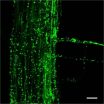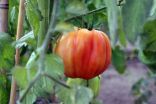(Press-News.org) This press release is available in German.
Soil is the most species-rich microbial ecosystem in the world. From this incredible diversity, plants specifically choose certain species, give them access to the root and so host a unique, carefully selected bacterial community from which they then benefit in a variety of ways. To achieve this, the plant's immune system must be able to tell which of these bacteria are friends and which foes. Researchers from the Max Planck Institute for Plant Breeding Research in Cologne and the Max Planck Institute for Marine Microbiology in Bremen have now discovered that the model plant Arabidopsis preferentially takes up three bacterial phyla into its roots: Actinobacteria, Proteobacteria and Bacteroidetes. This community of microbes is dependent on soil type and plant genotype.
The scientists have been breaking new ground in plant science with their investigation. It is only in recent years that the significance of microbial communities has been receiving wider attention. Even humans have more microorganisms than cells inside them, which means that any living organism can be regarded as a metaorganism. Schulze-Lefert and his colleagues have conducted acensus of the Arabidopsis root and identified varying quantities of 43 bacterial phyla. It may therefore be concluded that Arabidopsis makes a selection of the inhabitants of its roots from the profusion of microorganisms in the soil.
In drawing up the census, Schulze-Lefert and his colleagues investigated three habitats: root tissue with the bacteria residing there, the rhizosphere directly adjacent to the root, and unplanted soil in the surroundings of the test plants. "Three phyla of bacteria are dominant in the roots", says Schulze-Lefert. "These are Proteobacteria, Bacteroidetes and Actinobacteria, and each of these phyla is represented there by a major class or family. The nature of the soil and the genotype of the particular Arabidopsis plant obviously also have an influence on which bacteria are taken up into the roots."
The researchers cultivated the test plants either in loamy, silty soil from the Cologne Lowland or in sandy soil from the river and lake landscape around Golm in the federal state of Brandenburg. They also investigated two different ecotypes of Arabidopsis, each adapted to a very specific location. The fact that there are differences in the respective microbial communities between the two ecotypes also indicates that the bacteria must be selectively concentrated in the roots. "One of the bacterial species occurs ten times more frequently in one of the ecotypes than in the other", says Schulze-Lefert.
"We of course also wondered whether the community of bacteria has come together in the root merely by chance or whether there actually is a concentration system using molecular 'admission tickets', as we suspect", comments Schulze-Lefert on the results. The scientists therefore investigated the distribution pattern of the bacteria, namely which species can only be found on dead organic material, which are primarily present in the roots and which are to be found both on dead material and in root.
The bacteria which only settle on dead material must deliberately be kept at a distance by the plants. Of the three large groups of bacteria, it is primarily the Actinobacteria that predominate in the living root. "There must therefore be a molecular 'invitation' for this group", says Schulze-Lefert. "We don't know what it looks like, but the results cannot be explained in any other way. The important question that then arises is how the plant's immune system tolerates the useful bacteria. In other words, how does Arabidopsis tell friend from foe?" Plants are not usually timid when it comes to defending themselves from phytopathogenic bacteria. Pathogenic invaders are quickly recognised from their characteristic patterns and then subjected to the full force of the plant's immune system.
The group of bacteria which are found both on dead material and in the roots are also of interest. After all, this group makes up more than 40 percent of the bacterial community in the root. Dr. Schulze-Lefert's Cologne-based team are working on the assumption that these bacteria are primarily adapted for specific parts of the plant cell wall, which are identical in living and dead material, and are attracted by these constituents. A similar selective concentration of specific bacteria in the root is also found when comparing Arabidopsis plants from the wild with greenhouse specimens.
INFORMATION:
Original publication:
Davide Bulgarelli, Matthias Rott, Klaus Schlaeppi, Emiel Ver Loren van Themaat, Nahal Ahmadinejad, Federica Assenza, Philipp Rauf, Bruno Huettel, Richard Reinhardt, Elmon Schmelzer, Joerg Peplies, Frank Oliver Gloeckner, Rudolf Amann, Thilo Eickhorst & Paul Schulze-Lefert
Revealing structure and assembly cues for Arabidopsis root-inhabiting bacterial microbiota
Nature, August 2, 2012, doi: 10.1038/nature11336
Bacterial community inside the plant root
Plants choose the soil bacteria that they allow into their roots
2012-08-03
ELSE PRESS RELEASES FROM THIS DATE:
Ethylene of no effect -- why peppers do not mature after picking
2012-08-03
This press release is available in German.Tomato breeders scored a coup several years ago when they identified tomatoes with a genetic defect that made the fruits mature very slowly, even under the influence of the phytohormone ethylene. Traders and growers were delighted as it gave them more time to transport the crop, initially still green, from where it was harvested to where it would be sold. At the stores, the tomatoes could then be treated with ethylene to bring them to maturity. Other fruits, like peppers, grapes and strawberries, generally do not mature after picking; ...
Mystery of elephant infrasounds revealed
2012-08-03
Elephants can communicate using very low frequency sounds, with pitches below the range of human hearing. These low-frequency sounds, termed "infrasounds", can travel several kilometers, and provide elephants with a "private" communication channel that plays an important role in elephants' complex social life. Their frequencies are as low as the lowest notes of a pipe organ.
Although the sounds themselves have been studied for many years, it has remained unclear exactly how elephant infrasounds are made. One possibility, favored by some scientists, is that the elephants ...
MAK value lowered for chlorinated biphenyls
2012-08-03
This press release is available in German.Chlorinated biphenyls (PCBs) are a group of substances for which the 2012 List of MAK and BAT Values submitted by the Senate Commission for the Investigation of Health Hazards of Chemical Compounds in the Work Area of the Deutsche Forschungsgemeinschaft (DFG, German Research Foundation) specifies new, and in this case, significantly lower values than previously recommended. The current list, which was presented to the German Federal Minister of Labour and Social Affairs as in every year, and which is the basis for legislation on ...
NUS researchers identify a novel double-stranded DNA structure
2012-08-03
Contact: Tsueyling Yong
sciytl@nus.edu.sg
65-651-67874
Carolyn Fong
Carolyn@nus.edu.sg
65-6516-5399
National University of Singapore
NUS researchers identify a novel double-stranded DNA structure
Researchers' findings address a scientific debate that had lasted for 16 years over the existence of a double-stranded DNA structure
Double-stranded DNA has often been described as a right-handed helical structure, known as B-DNA. To perform its multiple functions, double-stranded DNA has multiple structures depending on conditions. For example, the melted DNA ...
People with allergies may have lower risk of brain tumors
2012-08-03
COLUMBUS, Ohio - New research adds to the growing body of evidence suggesting that there's a link between allergies and reduced risk of a serious type of cancer that starts in the brain. This study suggests the reduced risk is stronger among women than men, although men with certain allergy profiles also have a lower tumor risk.
The study also strengthens scientists' belief that something about having allergies or a related factor lowers the risk for this cancer. Because these tumors, called glioma, have the potential to suppress the immune system to allow them to grow, ...
MDC researchers develop new approach to treat acute liver failure
2012-08-03
Acute liver failure is a life-threatening disease, characterized by a sudden, massive death of liver cells. Unfortunately, few treatment options exist, especially for advanced-stage liver failure. As a last resort a liver transplant may be the only remaining option. Now the physician Dr. Junfeng An of the Max Delbrück Center for Molecular Medicine (MDC) Berlin-Buch and Dr. Stefan Donath, a specialist in internal medicine and cardiology, also of the MDC and Helios Klinikum Berlin-Buch, have developed a new treatment approach based on a mouse model. In their current study ...
Major step taken towards 'unbreakable' message exchange
2012-08-03
Single particles of light, also known as photons, have been produced and implemented into a quantum key distribution (QKD) link, paving the way for unbreakable communication networks.
The results of the experiment, undertaken by a close collaboration of researchers based in Wuerzburg, Munich and Stuttgart, have been published today, Thursday 2 August, in the Institute of Physics and German Physical Society's New Journal of Physics.
The single photons were produced using two devices made of semiconductor nanostructures that emitted a photon each time they were excited ...
Students with strong hearts and lungs may make better grades, study finds
2012-08-03
ORLANDO, Fla. -- Having a healthy heart and lungs may be one of the most important factors for middle school students to make good grades in math and reading, according to findings presented at the American Psychological Association's 120th Annual Convention.
"Cardiorespiratory fitness was the only factor that we consistently found to have an impact on both boys' and girls' grades on reading and math tests," said study co-author Trent A. Petrie, PhD, professor of psychology and director of the Center for Sport Psychology at the University of North Texas. "This provides ...
Parents get physical with unruly kids, study finds
2012-08-03
EAST LANSING, Mich. — Parents get physical with their misbehaving children in public much more than they show in laboratory experiments and acknowledge in surveys, according to one of the first real-world studies of caregiver discipline.
The study, led by Michigan State University's Kathy Stansbury, found that 23 percent of youngsters received some type of "negative touch" when they failed to comply with a parental request in public places such as restaurants and parks. Negative touch included arm pulling, pinching, slapping and spanking.
"I was very surprised to see ...
Predatory beetles eavesdrop on ants' chemical conversations to find best egg-laying sites
2012-08-03
ANN ARBOR, Mich.—Predatory beetles can detect the unique alarm signal released by ants that are under attack by parasitic flies, and the beetles use those overheard conversations to guide their search for safe egg-laying sites on coffee bushes.
Azteca instabilis ants patrol coffee bushes and emit chemical alarm signals when they're under attack by phorid flies. In an article published online July 27 in the journal Ecology and Evolution, University of Michigan researchers and their colleagues show that pregnant lady beetles intercept the ants' alarm pheromones, which let ...
LAST 30 PRESS RELEASES:
Climate extremes triggered rare coral disease and mass mortality on the Great Barrier Reef
Direct observation reveals “two-in-one” roles of plasma turbulence
Humans rank between meerkats and beavers in monogamy ‘league table’
US fossil reveals early mass-burial event and ancient microbial attack
Sedative choice could improve outcomes for breathing tube patients
New superconducting thin film for quantum computer chips
Simulations reveal protein "dynamin" constricts cell membranes by loosening its grip
Nearly 1 in 5 UK emergency department patients cared for in corridors/waiting rooms
Heavy energy drink intake may pose serious stroke risk, doctors warn
Violence against women and children among top health threats: New global study reveals disease burden far larger than previously estimated
Predicting who is at risk of developing type 1 diabetes, as new drugs now available
New gene-mapping method unlocks hidden drivers of cancer
Ocean current and seabed shape influence warm water circulation under ice shelves
Call to increase funding for ‘invisible’ Deaf victim-survivors of domestic abuse
University of Maryland School of Medicine names distinguished scientist and academic leader Gerald M. Wilson, PhD, as Chair of the Department of Biochemistry and Molecular Biology
Receptors in mammary glands make livestock and humans inviting hosts for avian flu
Icy hot plasmas
Treating adults with autism: Maryland Clinical Center offers national blueprint for care after pediatric transition
University of Phoenix College of Doctoral Studies releases white paper on reclaiming control to build workforce resilience
NCCN Summit seeks to improve care for veterans and first responders with cancer from line-of-duty exposure
ERC Consolidator Grant for soft robotics researcher
Dual-action arts and wellbeing program transforms dementia care
The global plastic waste trade contributes to coastal litter in importing countries, study shows
UT Dallas partners with Tech Mahindra on AI innovation
Blinking less could signal the brain is working harder to listen, Concordia study shows
Male bonobos track females’ reproductive cycle to maximize mating success
New report outlines science priorities for human Mars exploration
Want to curb cannabis-related crashes? Don’t forget older adults, study finds
Expectant management vs medication for patent ductus arteriosus in preterm infants
Pew funds 7 new biomedical research collaborations
[Press-News.org] Bacterial community inside the plant rootPlants choose the soil bacteria that they allow into their roots




